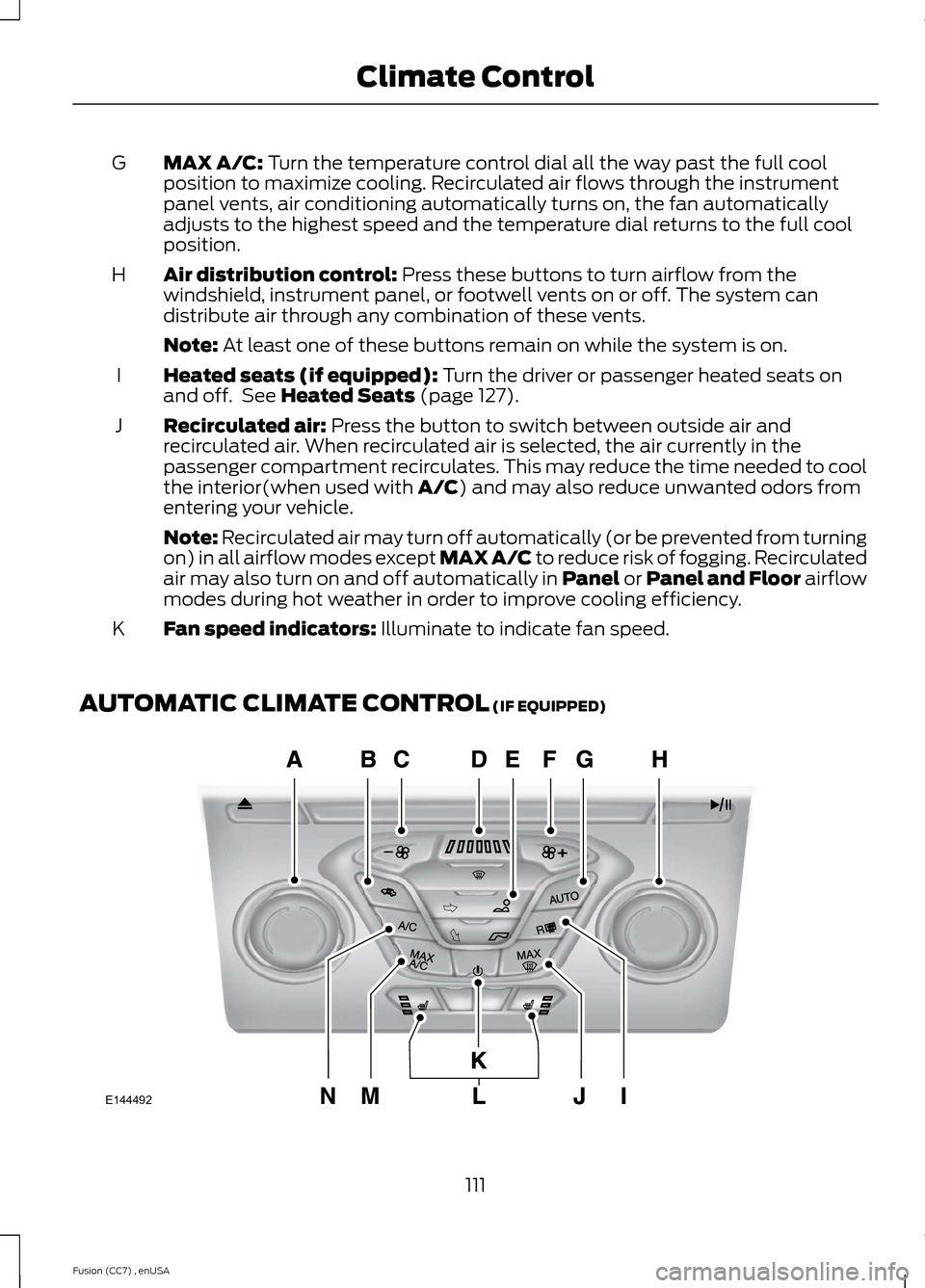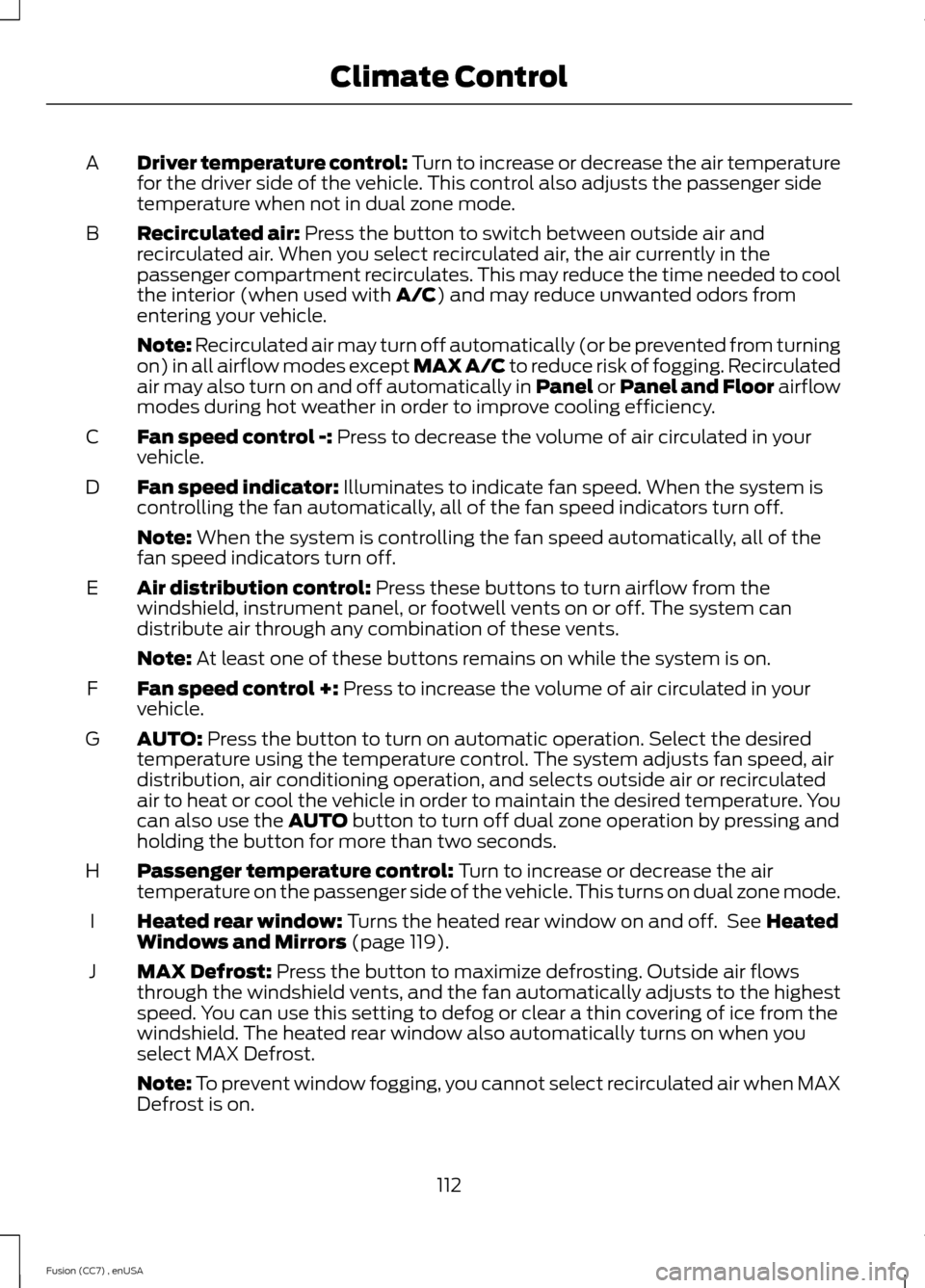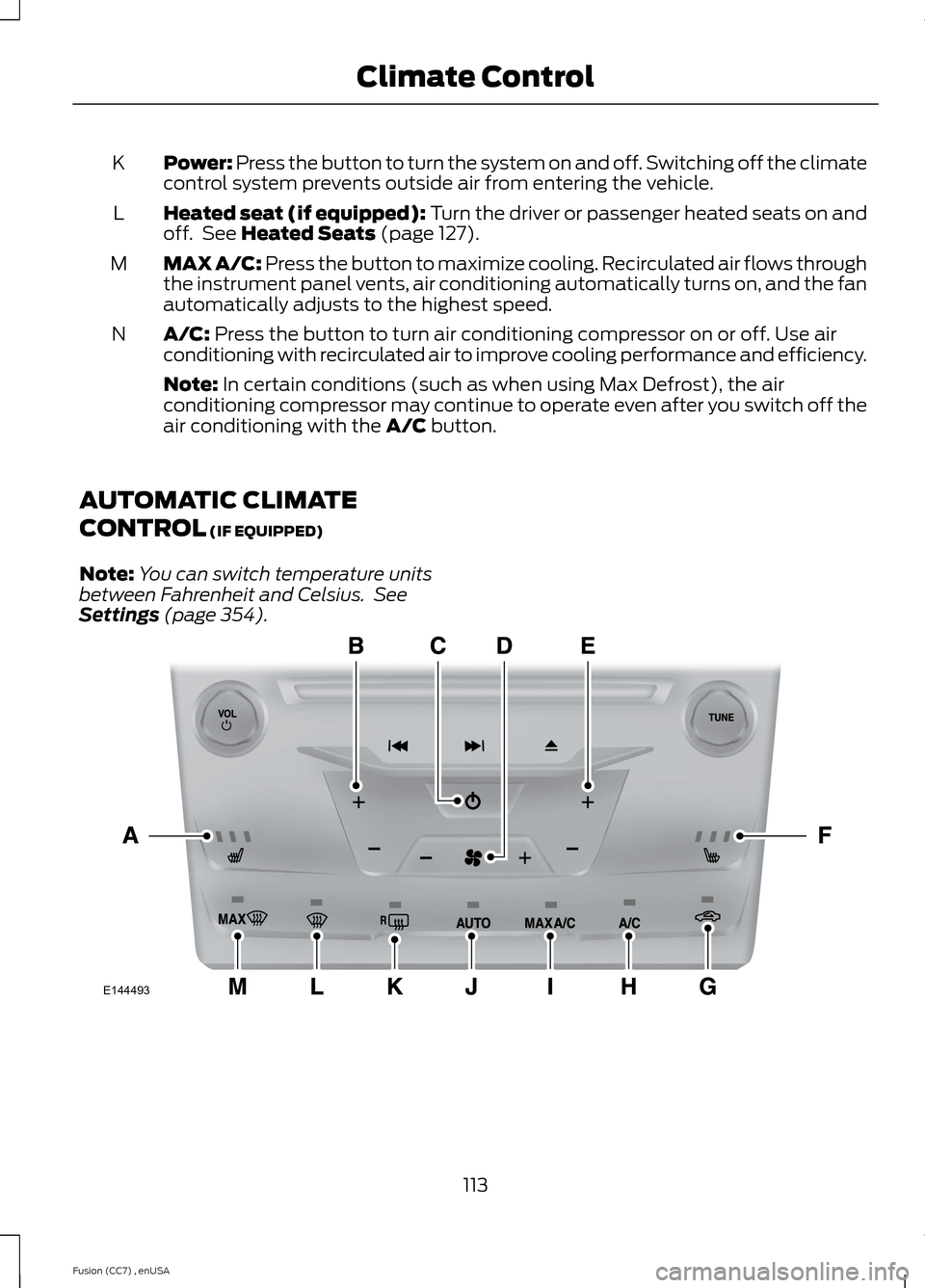2014 FORD FUSION (AMERICAS) instrument panel
[x] Cancel search: instrument panelPage 7 of 458

Ordering Additional Owner'sLiterature....................................................224
Reporting Safety Defects (U.S.Only).............................................................224
Reporting Safety Defects (CanadaOnly).............................................................225
Fuses
Fuse Specification Chart..........................226
Changing a Fuse...........................................235
Maintenance
General Information...................................236
Opening and Closing the Hood..............236
Under Hood Overview - 1.5L EcoBoost™/1.6L EcoBoost™.......................................238
Under Hood Overview - 2.0LEcoBoost™................................................239
Under Hood Overview - 2.5L..................240
Engine Oil Dipstick - 1.5L EcoBoost™/1.6L EcoBoost™........................................241
Engine Oil Dipstick - 2.0L EcoBoost™/2.5L................................................................241
Engine Oil Check...........................................241
Oil Change Indicator Reset......................242
Engine Coolant Check................................242
Automatic Transmission FluidCheck...........................................................245
Brake and Clutch Fluid Check.................245
Power Steering Fluid Check.....................245
Washer Fluid Check....................................245
Fuel Filter........................................................245
Changing the 12V Battery.........................245
Checking the Wiper Blades......................247
Changing the Wiper Blades.....................247
Adjusting the Headlamps........................248
Removing a Headlamp.............................249
Changing a Bulb............................................251
Bulb Specification Chart...........................253
Changing the Engine Air Filter.................255
Vehicle Care
General Information...................................256
Cleaning Products.......................................256
Cleaning the Exterior..................................256
Waxing..............................................................257
Cleaning the Engine....................................257
Cleaning the Windows and WiperBlades..........................................................258
Cleaning the Interior...................................258
Cleaning the Instrument Panel andInstrument Cluster Lens.......................258
Cleaning Leather Seats.............................259
Repairing Minor Paint Damage..............260
Cleaning the Alloy Wheels.......................260
Vehicle Storage............................................260
Wheels and Tires
Tire Care..........................................................263
Using Snow Chains.....................................278
Tire Pressure Monitoring System...........279
Changing a Road Wheel...........................282
Technical Specifications..........................286
Capacities and Specific-ations
Engine Specifications.................................287
Motorcraft Parts..........................................288
Vehicle Identification Number...............289
Vehicle Certification Label.......................289
Transmission Code Designation............290
Technical Specifications............................291
Audio System
General Information...................................294
Audio unit - Vehicles With: AM/FM/CD/SYNC/Satellite Radio............................295
Audio unit - Vehicles With: Premium AM/FM/CD..........................................................297
Audio unit - Vehicles With: Sony AM/FM/CD.................................................................299
4Fusion (CC7) , enUSATable of Contents
Page 40 of 458

Children must always be properlyrestrained. Accident statistics suggest thatchildren are safer when properly restrainedin the rear seating positions than in thefront seating position. Failure to followthese instructions may increase the risk ofinjury in a crash.
FRONT PASSENGER SENSING
SYSTEM
WARNINGS
Even with Advanced RestraintsSystems, children 12 and undershould be properly restrained in arear seating position. Failure to follow thiscould seriously increase the risk of injury ordeath.
Sitting improperly out of position orwith the seat back reclined too farcan take off weight from the seatcushion and affect the decision of the frontpassenger sensing system, resulting inserious injury or death in a crash.
To reduce the risk of possible seriousinjury: Do not stow objects in seatback map pocket or hang objects offseat back if a child is in the front passengerseat. Do not place objects underneath thefront passenger seat or between the seat
WARNINGS
and the center console. Check thepassenger airbag off or pass airbag offindicator lamp for proper airbag status.Failure to follow these instructions mayinterfere with the front passenger seatsensing system.
Any alteration or modification to thefront passenger seat may affect theperformance of the front passengersensing system.
This system works with sensors that arepart of the front passenger’s seat andsafety belt to detect the presence of aproperly-seated occupant and determineif the front passenger’s frontal airbagshould be enabled (may inflate) or not.
The front passenger sensing system usesa pass airbag off indicator which willilluminate and stay lit to remind you thatthe front passenger frontal airbag isdisabled.
The indicator lamp is located at the topcenter of the instrument panel.
Note:When the ignition is first tuned on,the indicator lamp will illuminate for a shortperiod of time to confirm it is functional.
The front passenger sensing system isdesigned to disable (will not inflate) thefront passenger's frontal airbag when arear facing infant seat, a forward-facingchild restraint, or a booster seat isdetected. Even with this technology,
37Fusion (CC7) , enUSASupplementary Restraints SystemE142846 E157152
Page 43 of 458

WARNINGS
If the side airbag has deployed, theairbag will not function again. Theside airbag system (including theseat) must be inspected and serviced byan authorized dealer. If the airbag is notreplaced, the unrepaired area will increasethe risk of injury in a crash.
The side airbags are located on theoutboard side of the seatbacks of the frontseats. In certain sideways crashes, theairbag on the side affected by the crashwill be inflated. The airbag was designedto inflate between the door panel andoccupant to further enhance the protectionprovided occupants in side impact crashes.
The system consists of the following:
•A label or embossed side panelindicating that side airbags are fittedto your vehicle.
•Side airbags located inside the driverand front passenger seatbacks.
•Front passenger sensing system.
·Crash sensors and monitoringsystem with readiness indicator.See Crash Sensors and AirbagIndicator (page 42).
Note:The passenger sensing system willdeactivate the passenger seat-mountedside airbag if it detects an empty passengerseat.
The design and development of the sideairbag system included recommendedtesting procedures that were developedby a group of automotive safety expertsknown as the Side Airbag TechnicalWorking Group. These recommendedtesting procedures help reduce the risk ofinjuries related to the deployment of sideairbags.
DRIVER AND PASSENGER
KNEE AIRBAGS
Driver and passenger knee airbags arelocated under or within the instrumentpanel. During a crash, the restraints controlmodule may activate the driver andpassenger knee airbags (individually orboth) based on crash severity andrespective occupant conditions. Undercertain crash and occupant conditions, thedriver and passenger knee airbags maydeploy (individually or both) but thecorresponding front airbag may notactivate. As with front and side airbags, itis important to be properly seated andrestrained to reduce the risk of death orserious injury.
Make sure the knee airbags areoperating properly. See CrashSensors and Airbag Indicator(page 42).
SIDE CURTAIN AIRBAGS
WARNINGS
Do not place objects or mountequipment on or near the headlinerat the siderail that may come intocontact with a deploying side curtainairbag. Failure to follow these instructionsmay increase the risk of personal injury inthe event of a crash.
40Fusion (CC7) , enUSASupplementary Restraints SystemE152533
Page 52 of 458

The tag with your transmitter details thestarting procedure.
To remote start your vehicle:
1.Press the lock button to lock all thedoors.
2.Press the remote start button twice.The exterior lamps will flash twice.
The horn will sound if the system fails tostart, unless quiet start is on. Quiet startwill run the blower fan at a slower speedto reduce noise. It can be switched on oroff in the information display. See GeneralInformation (page 87).
Note:If the vehicle has been remote startedwith an integrated keyhead transmitter, youmust switch the ignition on before drivingyour vehicle. With an intelligent accesstransmitter, you must press theSTART/STOP button on the instrumentpanel once while applying the brake pedalbefore driving your vehicle.
The power windows will not work duringthe remote start and the radio will not turnon automatically.
The parking lamps will remain on and thevehicle will run for 5, 10, or 15 minutes,depending on the setting.
Extending the Vehicle Run Time
Repeat Steps 1 and 2 with the vehicle stillrunning to extend the run time for anotherremote start duration. If you programmedthe duration to last 10 minutes, the second10 minutes will begin after what is left ofthe first activation time. For example, if thevehicle had been running from the firstremote start for five minutes, the vehiclewill continue to run now for a total of 15minutes. You can extend the remote startup to a maximum of 35 minutes.
Wait at least five seconds before remotestarting after a vehicle shutdown.
Turning the Vehicle Off After RemoteStarting
Press the button once. Theparking lamps will turn off.
You may have to be closer to thevehicle than when starting due to groundreflection and the added noise of therunning vehicle.
You can disable or enable the remote startsystem through the information display.See General Information (page 87).
REPLACING A LOST KEY OR
REMOTE CONTROL
Replacement keys or remote controls canbe purchased from an authorized dealer.Authorized dealers can program remotecontrols for your vehicle. See PassiveAnti-Theft System (page 61).
To re-program the passive anti-theftsystem see an authorized dealer.
49Fusion (CC7) , enUSAKeys and Remote ControlsE138626 E138625
Page 72 of 458

LIGHTING CONTROL
OffA
Parking lamps, instrument panellamps, license plate lamps andtail lamps
B
HeadlampsC
High Beams
Push the lever forward to switch the highbeams on.
Push the lever forward again or pull thelever toward you to switch the high beamsoff.
Headlamp Flasher
Pull the lever toward you slightly andrelease it to flash the headlamps.
AUTOLAMPS (IF EQUIPPED)
The headlamps will switch on and offautomatically in low light situations orduring inclement weather.
The headlamps will remain on for a periodof time after you switch the ignition off.Use the information display controls toadjust the period of time that theheadlamps will remain on. SeeInformation Displays (page 87).
69Fusion (CC7) , enUSALightingE142449 E162679 E162680 E142451
Page 114 of 458

MAX A/C: Turn the temperature control dial all the way past the full coolposition to maximize cooling. Recirculated air flows through the instrumentpanel vents, air conditioning automatically turns on, the fan automaticallyadjusts to the highest speed and the temperature dial returns to the full coolposition.
G
Air distribution control: Press these buttons to turn airflow from thewindshield, instrument panel, or footwell vents on or off. The system candistribute air through any combination of these vents.
H
Note: At least one of these buttons remain on while the system is on.
Heated seats (if equipped): Turn the driver or passenger heated seats onand off. See Heated Seats (page 127).I
Recirculated air: Press the button to switch between outside air andrecirculated air. When recirculated air is selected, the air currently in thepassenger compartment recirculates. This may reduce the time needed to coolthe interior(when used with A/C) and may also reduce unwanted odors fromentering your vehicle.
J
Note: Recirculated air may turn off automatically (or be prevented from turningon) in all airflow modes except MAX A/C to reduce risk of fogging. Recirculatedair may also turn on and off automatically in Panel or Panel and Floor airflowmodes during hot weather in order to improve cooling efficiency.
Fan speed indicators: Illuminate to indicate fan speed.K
AUTOMATIC CLIMATE CONTROL (IF EQUIPPED)
111Fusion (CC7) , enUSAClimate ControlE144492
Page 115 of 458

Driver temperature control: Turn to increase or decrease the air temperaturefor the driver side of the vehicle. This control also adjusts the passenger sidetemperature when not in dual zone mode.
A
Recirculated air: Press the button to switch between outside air andrecirculated air. When you select recirculated air, the air currently in thepassenger compartment recirculates. This may reduce the time needed to coolthe interior (when used with A/C) and may reduce unwanted odors fromentering your vehicle.
B
Note: Recirculated air may turn off automatically (or be prevented from turningon) in all airflow modes except MAX A/C to reduce risk of fogging. Recirculatedair may also turn on and off automatically in Panel or Panel and Floor airflowmodes during hot weather in order to improve cooling efficiency.
Fan speed control -: Press to decrease the volume of air circulated in yourvehicle.C
Fan speed indicator: Illuminates to indicate fan speed. When the system iscontrolling the fan automatically, all of the fan speed indicators turn off.D
Note: When the system is controlling the fan speed automatically, all of thefan speed indicators turn off.
Air distribution control: Press these buttons to turn airflow from thewindshield, instrument panel, or footwell vents on or off. The system candistribute air through any combination of these vents.
E
Note: At least one of these buttons remains on while the system is on.
Fan speed control +: Press to increase the volume of air circulated in yourvehicle.F
AUTO: Press the button to turn on automatic operation. Select the desiredtemperature using the temperature control. The system adjusts fan speed, airdistribution, air conditioning operation, and selects outside air or recirculatedair to heat or cool the vehicle in order to maintain the desired temperature. Youcan also use the AUTO button to turn off dual zone operation by pressing andholding the button for more than two seconds.
G
Passenger temperature control: Turn to increase or decrease the airtemperature on the passenger side of the vehicle. This turns on dual zone mode.H
Heated rear window: Turns the heated rear window on and off. See HeatedWindows and Mirrors (page 119).I
MAX Defrost: Press the button to maximize defrosting. Outside air flowsthrough the windshield vents, and the fan automatically adjusts to the highestspeed. You can use this setting to defog or clear a thin covering of ice from thewindshield. The heated rear window also automatically turns on when youselect MAX Defrost.
J
Note: To prevent window fogging, you cannot select recirculated air when MAXDefrost is on.
112Fusion (CC7) , enUSAClimate Control
Page 116 of 458

Power: Press the button to turn the system on and off. Switching off the climatecontrol system prevents outside air from entering the vehicle.K
Heated seat (if equipped): Turn the driver or passenger heated seats on andoff. See Heated Seats (page 127).L
MAX A/C: Press the button to maximize cooling. Recirculated air flows throughthe instrument panel vents, air conditioning automatically turns on, and the fanautomatically adjusts to the highest speed.
M
A/C: Press the button to turn air conditioning compressor on or off. Use airconditioning with recirculated air to improve cooling performance and efficiency.N
Note: In certain conditions (such as when using Max Defrost), the airconditioning compressor may continue to operate even after you switch off theair conditioning with the A/C button.
AUTOMATIC CLIMATE
CONTROL (IF EQUIPPED)
Note:You can switch temperature unitsbetween Fahrenheit and Celsius. SeeSettings (page 354).
113Fusion (CC7) , enUSAClimate ControlE144493